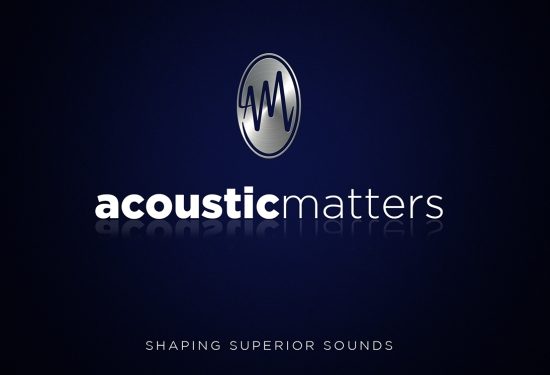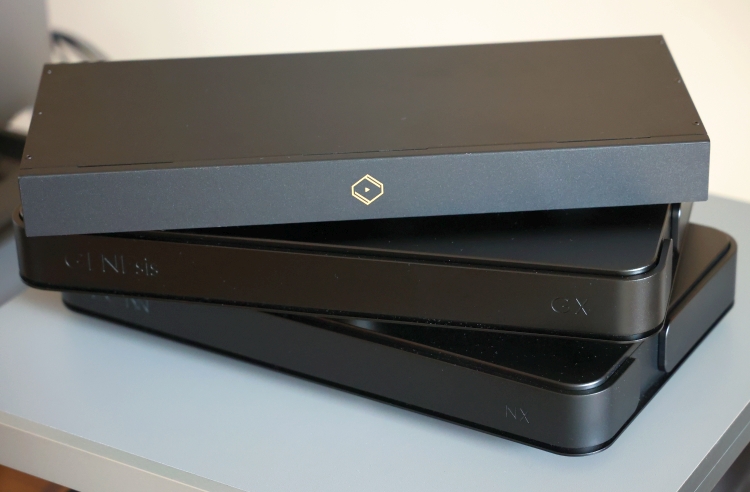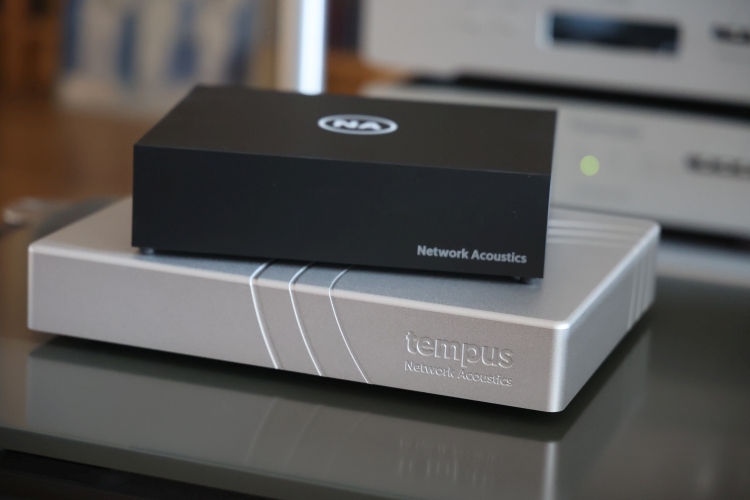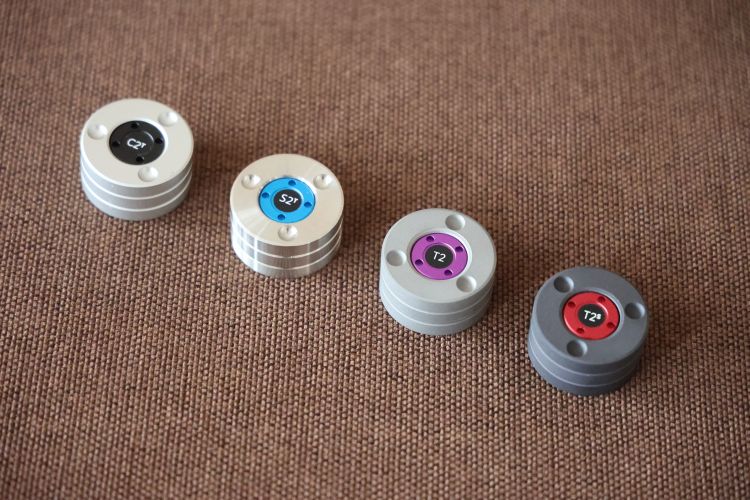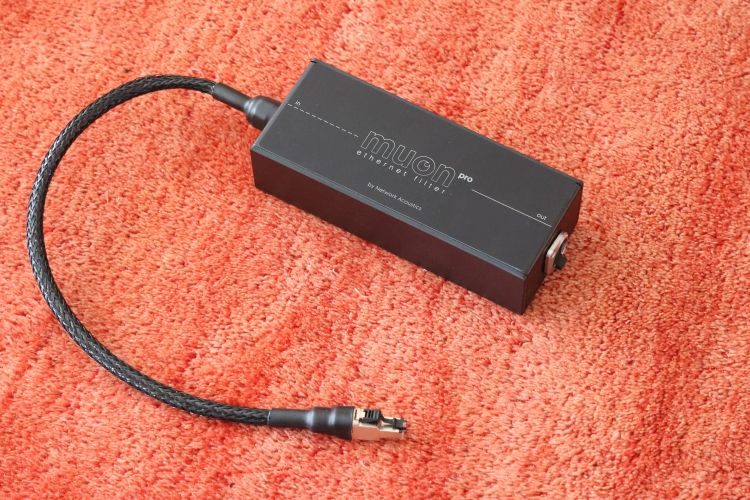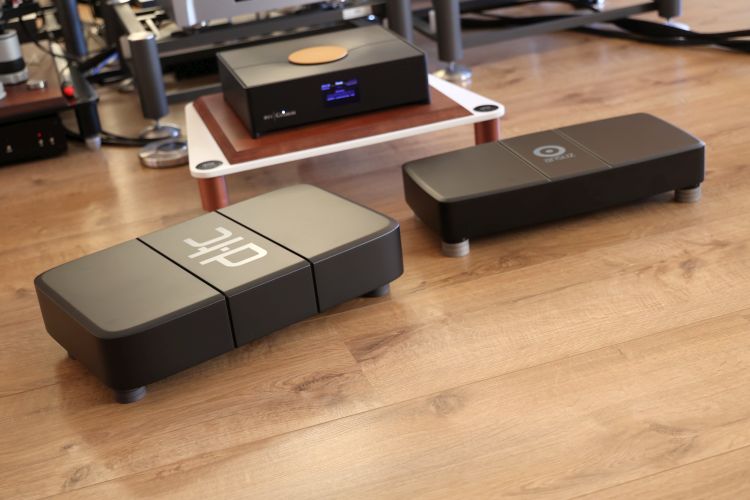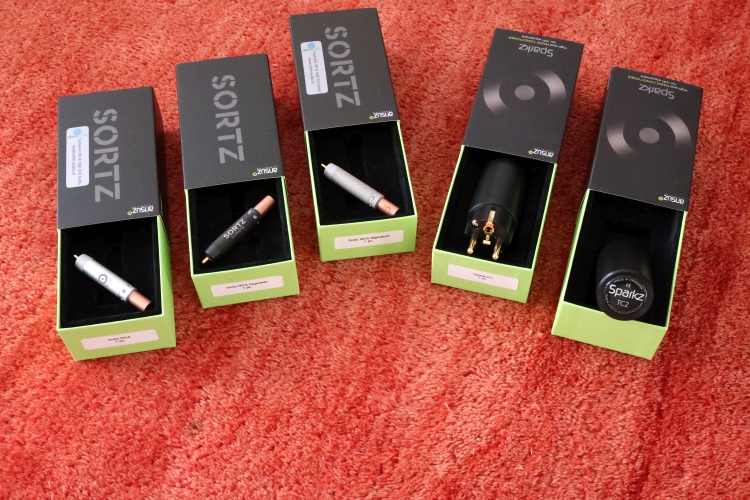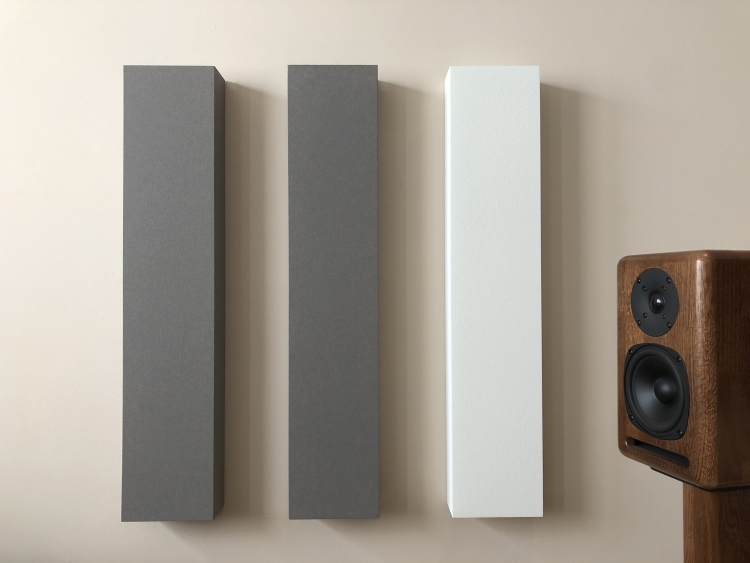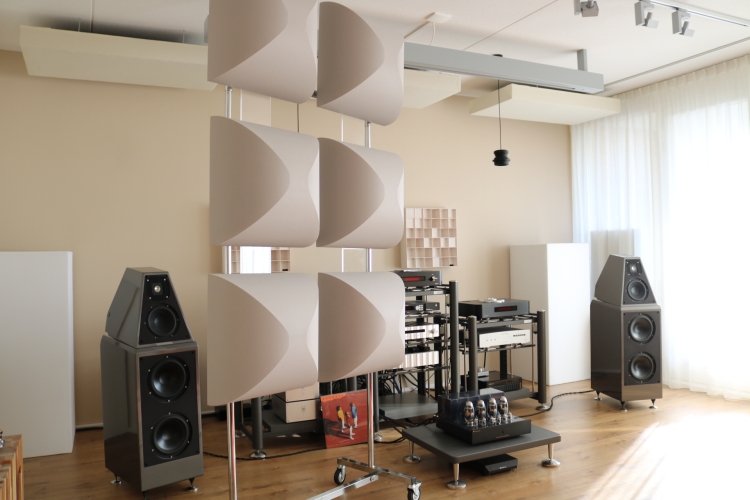
I never thought that I would ever need the help of a specialized company for optimizing my acoustics. What’s more, until a few years ago I did not even think that my room needed any treatment, other than the self-explanatory measures to avoid first reflections or reverb and flutter echoes. I was convinced that proper speaker positioning negated the need for acoustic treatments and thought that such treatments were really only required if you had an extraordinarily bad room. This would turn out to be a misconception and slowly but surely I changed my mind.
After having applied bass traps very successfully in the second room where I used Genelec 8050 active monitors, I started experiments in the main listening room, and with success. The thing is that the large dipoles that I used (first Magnepans, then Apogees) respond very differently in a room than most dynamic speakers do. Especially Room Modes (Room Resonance Frequencies) were not an issue at all with the Apogee Divas, or at least not in a detractive manner. With the Wilson Watt/Puppy 8’s, however, the modes really are excited to disturbing levels and I could not get this right with positioning alone. This incurred the realization that speaker positioning is indeed paramount, but careful use of acoustical treatment is required to bring further improvements that cannot be obtained with speaker positioning alone. Also, I now realized that my room was in fact far from ideal in the first place.
Finding the first reflection points is easy and it is not too difficult to find good positions for the speakers in a given room by trial and error. But determining the cause of room modes and properly dealing with them can be pretty difficult. And when there are several modes and nulls as well as peaks, then it becomes near-impossible to fix without certain equipment and perhaps even more importantly, the proper knowledge. This was my trigger for reaching out for help and that is where a specialized company such as AcousticMatters comes in!

AcousticMatters
AcousticMatters is enthusiastically headed by Ben van Leliveld. The services include Calibrated Measurements, Computer Simulation, Listening, Layout Design, Tuning and Installation of Treatment products.
Before he had optimized my system I thought that I had already found the optimal relative positions for the sofa and the speakers. Also, I considered myself to be pretty well-versed in these matters. As it turned out, however, I had been adjusting from the wrong starting point because the first thing that should have been done was to remove the excess bass in the room caused by room modes and only then start adjusting the speaker- and listening positions. Not having done this in the first place resulted in the need to have the speakers much further into the room than ideal. In these positions, the biggest room resonances were not too disturbing most of the time but still there when certain notes were played with a lot of energy. To make matters worse, the lowest bass rolled off way too early, making the Wilsons sound like much smaller speakers than they are.
It’s not that I had not tried to get rid of the resonances, but even when using 10 pieces of GiK 244 Broadband Bass Traps I could only diminish the annoying peaks very slightly. As I would learn later, I needed very different bass traps.
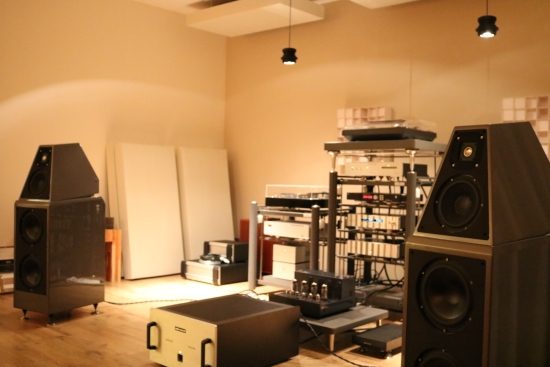
Above: speakers in their initial positions, with lots of Broadband bass traps behind them.
Initial Session
Naturally, I gave Ben Carte Blanche for setting up the system according to his ideas and convictions, and so he started work, which would take a full 4 hours on that first night alone. During this time, Ben would do all the work while I kept asking questions, which he all patiently replied to.
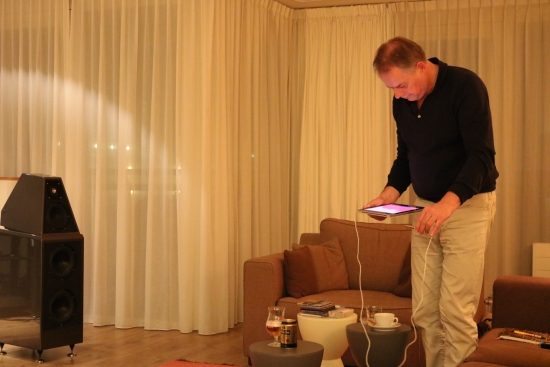
Measurements
Before measuring, Ben first listens to the system using his own reference tracks, to get a good hold on the situation, and because, well, you can’t measure everything. Or rather, for some aspects, we don’t know how to measure them, so listening remains key! After that, the measuring starts. Ben uses a special iPad application and a specific microphone on a stand that is placed in the listening position to measure white noise played from a CD or audio file over the audio system. The iPad shows the response in real time and can store snapshots as well, which he will use later for his report. After this initial measurement he takes the microphone in his hand and moves forward and backward to find resonance peaks and nulls and again takes snapshots and repeats this in several other places in the room. The biggest surprise was not that I have multiple room modes, this I knew already, but that they are really quite severe! For example, there’s a big dip below 100hz followed by a very big peak at 120hz and some more, smaller, peaks in several other places. The main peak was no less than 20dB higher than the average signal level. Remember: 6dB gives a doubling of the perceived level, so go figure! It was no wonder that I was unhappy with the sound.
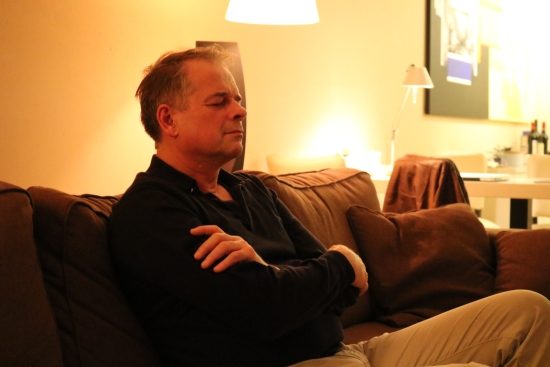
After his first assessments, Ben commented that the speakers had been set up very precisely by me, but much further into the room than he thought to be ideal. Sofa position was another factor where I would turn out to have made the wrong decision. When seated originally, my head was positioned approximately 1 meter from the rear wall which I found to be ideal for my situation, but Ben indicated that the sofa should ideally be at two-thirds of the room, so several more meters further from the rear wall. Of course, Ben’s suggestion follows sane rules of which I am aware, but these just did not work out in my room, or, at least, not until I had the correct bass traps. Ben maintained that this would be the ideal position and proceeded to move the speakers to the positions where he figured they should be, which was about 1 meter backward, closer to the rear wall. As I had already tried this I knew that it would not work but he maintained that these were the best positions. He then proceeded to play a certain audio track on repeat while he moved the right-hand speaker in very small increments, left and right as well as forward and backward. After 15-20 minutes he proceeded to do the same for the left speaker but soon realized that this corner was much heavier on the bass and so this speaker needed to be positioned much further from the rear wall than the other speaker did. My room has hard walls on the left-, front- and rear side and a glass wall on the right-hand side. Even though the left side has an open kitchen as well as a hallway, it was easy to see in Ben’s measurements that the left wall builds up bass energy while the glass wall absorbs bass energy. This meant that the left speaker would be leading in positioning and the right one was then to follow.
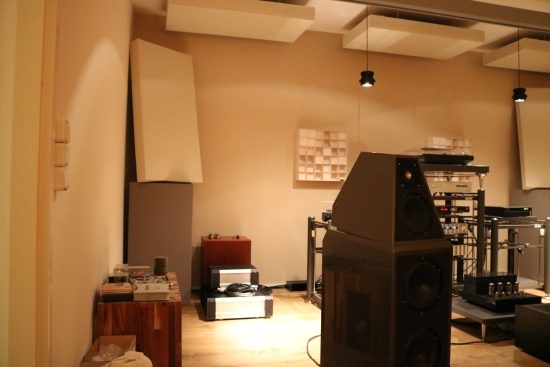
Above: the two R.T.F.S. Big Blocks were not enough, but adding the GiK Broadband bass traps did not help much for my particular problem. Below: double Big Blocks in each corner went a long way toward solving my problem.
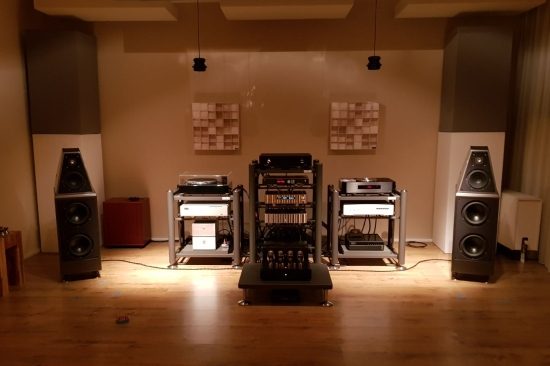
After another 15 minutes of incremental speaker positioning, Ben played two audio tracks that he knows very well, and which represent a very large amount of aspects to judge the various audio parameters by, while repeatedly making more small changes to the speakers’ positions. After that, he moved the sofa to the aforementioned two-thirds position, about 2.5 or so meters from the rear wall, creating a passage behind it, which I didn’t mind but also making the room seem smaller but hey, it’s all about the sound, and less about aesthetics. This sofa position was chosen entirely based on room dimensions, so not based on sound checks, because Ben knows from experience that this should be the ideal position to make for the least room-induced colorations and the best imaging.
No more measurements were taken at this time but when seated in the new listening position, some bass notes were now truly unbearable. This was the cue for Ben to add the R.T.F.S. Big Blocks to the mix. These are large bass traps made from several materials, with an extremely high damping factor and a very low reach – much lower apparently than the GiK 244 Broadband Bass Traps that I used. With one of them in position in the corners behind each speaker, the resonance itself was not so much reduced but the decay of the resonance was indeed much shorter and the bass was now much more articulate. This was better indeed, but the peaks were still quite annoying. Now moving both Big Blocks to the left corner in a stacked fashion, we had something of a breakthrough. While still not exactly linear, the bass peaks were now definitely less prevalent, and the music almost listenable.
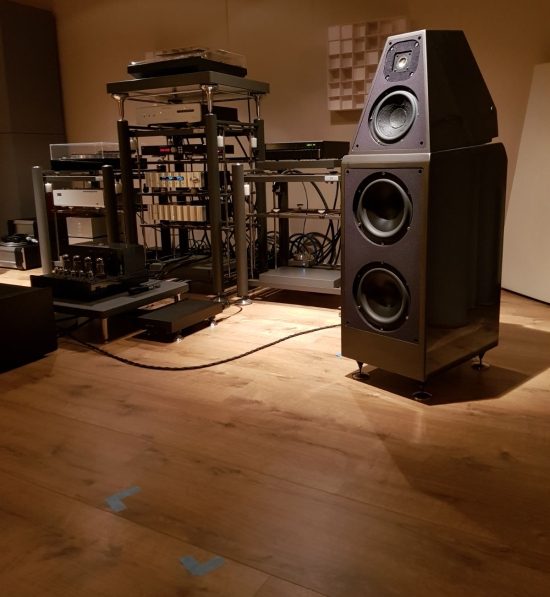
Notice the blue tape marking the original position on the floor? The speakers really were moved significantly!
What’s more, and what I totally did not expect, was a huge step forward in imaging. Not only was the focus and transparency now simply superb, but vocals were also truly lifelike and completely decoupled from the speaker enclosures, floating, no, make that hammered, freely in space. Timbre was already very convincing but had now improved massively as well, making for the absolutely most convincing natural piano- and percussion sounds that have ever heard before – in this room or anywhere else! I don’t use this term loosely, but the improvement in sound was simply spectacular!
However, at this stage, the bass problems were not yet gone, so Ben moved the Sofa back by about 1 meter, at which point the most annoying peak was entirely nulled, but the dips had become worse than they were before, and very low bass notes were now rolling off even earlier than they initially did, making for an overly clean sound. None of this had a negative effect on the imaging however so at this time I was quite content, even if I knew that more work was required. Ben left, content as well, promising to come back soon with more bass traps to finish the room treatment. Meanwhile, I could borrow the two Big Blocks that we used for the tests. After a while, though, I grew unsatisfied with the thin bass and found that there was still a big bass peak, but at a different frequency than before.
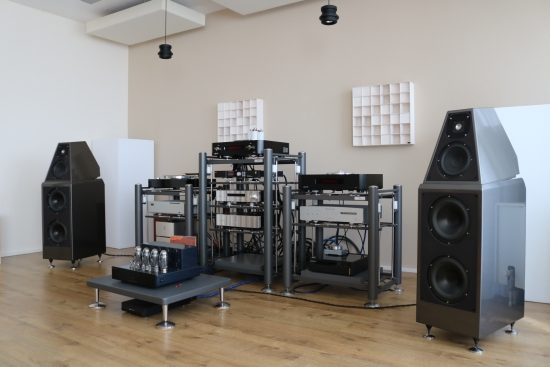
SiRRAH
Ben also dropped off 6 SiRRAH units for me to experiment with. These are diffusers but also bass traps, and quite effective ones at that, too! I tried them in various positions and while they certainly did a very good job of removing reflections, I found that their effect was not what I needed in this room. I did find that their bass resonance damping capacity really is amazing indeed, one SiRRAH doing at least as much in the low bass as a much bigger GiK 422 Broadband bass trap.
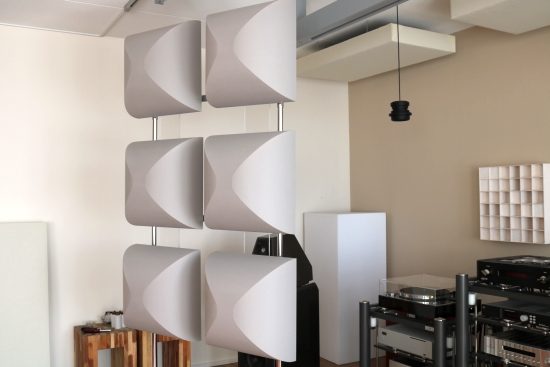
The SiRRAHs were accompanied by a rack onto which the units could simply be stuck using magnets.
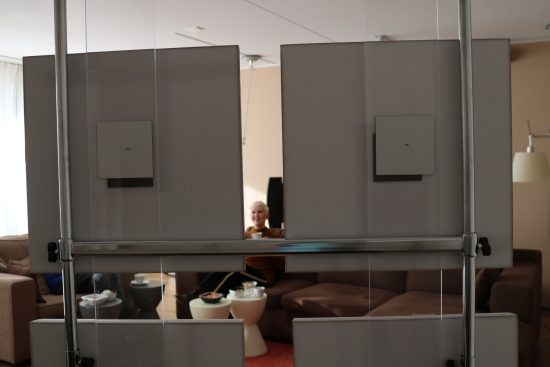
Session 2
For the second session, Ben brought along two more Big Blocks. We quickly learned that the extra two Blocks helped, but did not cure my bass issues entirely and after I made it clear that this was the main issue for me and the other audiophile parameters came second, Ben proceeded to reposition the speakers such that the bass actually became quite well-behaved. He did this by moving the speakers in small increments while assessing their cabinet resonances and placing them such that they resonated the least.
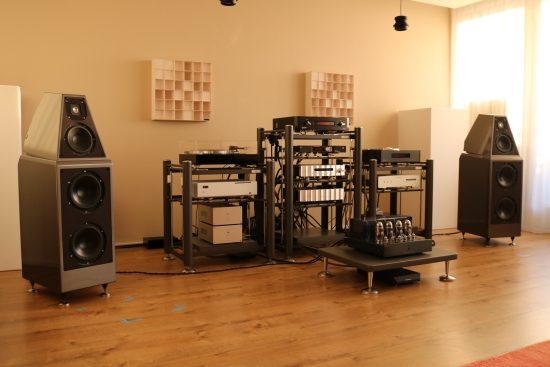
Above: speakers even closer to the rear wall did remove the boominess but introduced other issues.
Ben may want to correct me on this but I think that the result of this was that the speakers were placed such that their peaks were overlapping with the out of phase room resonances, very effectively nulling the annoying peak in the process. But in the process, the focus and soundstaging had been sacrificed, and more severely, there was an overall sense of a lack of dynamic energy. As Ben had already invested quite a lot of time and I was quite tired at this point, we agreed that he would leave it at this now and I would carry on the work using the 4 loaner blocks.
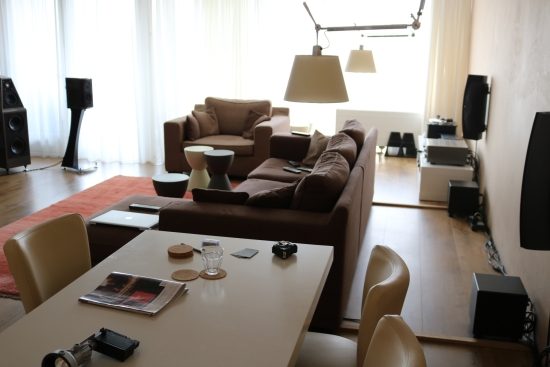
Above: sofa position after Ben’s second visit.
Using my own knowledge as well as all the newly learned tricks, I tried my best to improve the situation but invariably whenever one aspect of the sound was optimized, another would suffer. I arrived at a setup that very good focus and soundstaging and otherwise also worked for the most part, but only as long as no music was played that used certain notes, which, all things considered, was a partial improvement over the initial situation but my issues were not yet solved entirely.
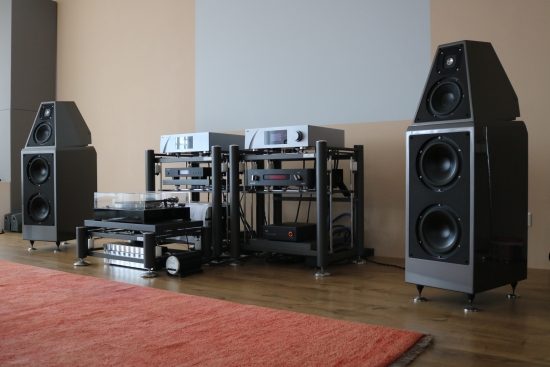
The Breakthrough
Ever since I got the Wilsons, placed at the same end of the room as the Apogees, I had the feeling that my system needed to be rotated 180 degrees, back to where the Magnepans and Apogees were, before I moved them to the other side to improve their bass response. The Wilsons actually seemed to need the inverse treatment. However, once the Wilsons were at the other end of the room, and my sofa at the inverse end, near the wall, an old problem returned. Rather than the enormous bass peak, there was now an enormous bass gap, I’d say at around 100 Herz. The same thing happened with the Magnepans and Apogees, which is why I obtained subs in the first place and then moved the speakers to the other side, and no longer needed the subs.
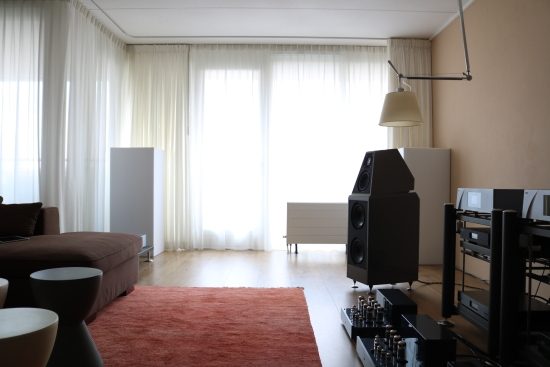
Initially, I used one Big Block in each corner, which helped immensely. If I stacked the two units, the dampening effect was larger but the overall effect less pronounced.
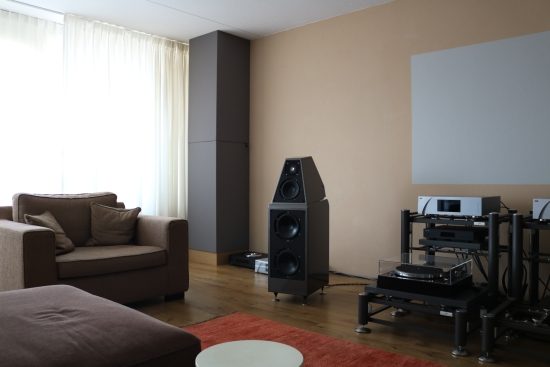
Later I found that stacking them in the corner behind the speaker actually worked best, but only if the rear wall corners were treated one Big Block each.
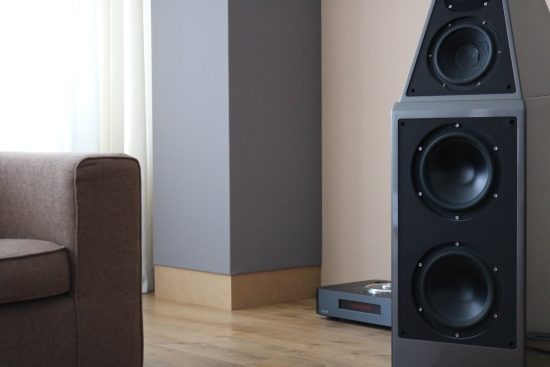
The tallest size per block is 123cm so two of them was not enough to fit my 260cm height. It was no problem to arrive at my required height by using 3 blocks and a single sock but I preferred to keep the blocks dividable. So, I resorted to making a pedestal myself out of MDF. Later I learned that 12cm spray-painted filler blocks are available.
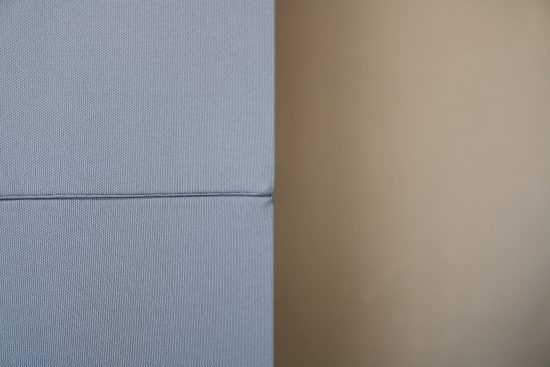
The fabric is removable and fits the product really neatly and when stacked, the units have the exact same dimensions.
In the meantime, my 4 ordered Big Blocks had arrived. Now my newfound knowledge came in really handy. Rather than accepting the bass gaps or trying to minimize them by pulling the speakers way forward, I quickly found that Ben’s suggestion to put the speakers relatively close to the rear wall and the sofa on about two-thirds of the room yielded the best results. Having the listening position in the middle of the room induces the least resonances, but also takes away the support in the bass that many people actually like, myself included. Placing the speakers closer to the rear walls, however, nicely compensates for this.
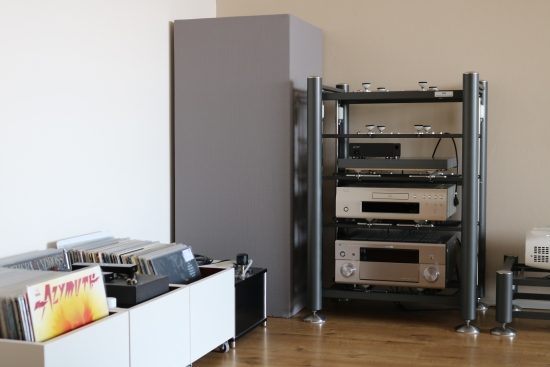
Above and below: a single Big Block in each of the rear wall’s corners.
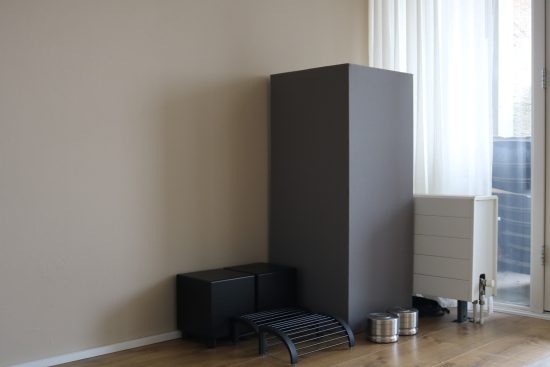
But now there were other issues: the bass was not peaky anymore but there was quite a bit of reverb at certain bass frequencies, masking articulation and taking away precision. This is where the 4 Big Blocks came in again! It took some experimenting, but they are very light and easy to place, and so I found 3 corners that needed to be treated. When the main corner was treated with two Blocks, the reverb was gone but with some notes, I still heard an out-of-phase effect, behind me! As Ben had already found out in the initial setup, this side of the room creates both peaks and nulls, and this was still an issue even with the speakers at the other end. Simply placing the remaining two Blocks in the left and right corners completely cleaned up the sound.
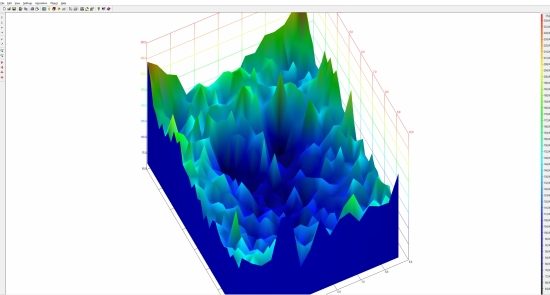
Above and below: normally Ben will create an extensive report containing before and after measurements, complete with computer simulations and other interesting graphs. These images are not representative of my situation, but the top one shows how the sound tends to get ever more colored (the green parts) near the walls. If the situation in my room was displayed in this graphic then there would be some big orange and red parts in it.
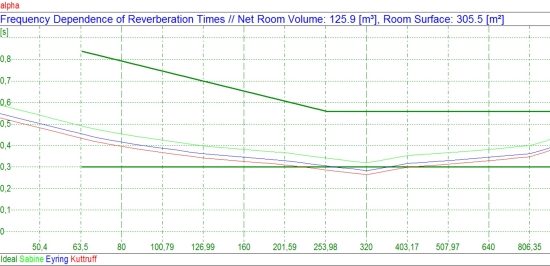
Never before have I been able to place dynamic speakers so close to the wall without this ending up in a boomy bass. Now, however, I finally had a tight and articulate bass with very good depth and no boominess whatsoever.
Summing Up
Speaker- and listening seat positioning remain the most important matters, but you can’t achieve perfection without careful treatment of the room. In my new setup, I now have incredible focus and transparency to rival the best I’ve heard from the best Apogees, along with truly excellent bass – thanks to Ben’s efforts and the amazingly effective R.T.F.S. Big Blocks.

External Links
AcousticMatters website: AcousticMatters
R.T.F.S manufacturer’s website: R.T.F.S.de
Dealer for the Netherlands: Chattelin Audio Systems
